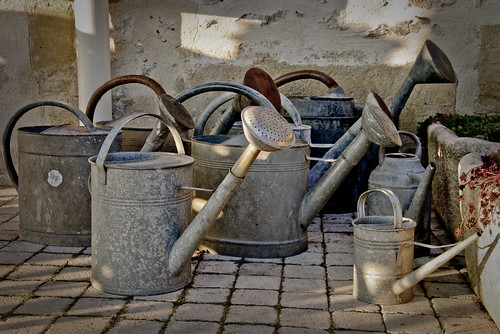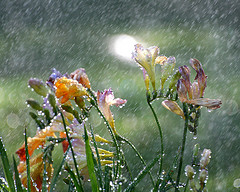Successful Watering in your Garden

Watering can be the key to success in the garden and with your houseplants. Not surprisingly plants without water die ! Plants can drown with too much H²O so watering is a skill worth learning.
It sounds so easy when you are told to ‘water your plants’. Well so it is but there is many a slip twixt watering can and lip. Remember you are watering the soil not the leaves.
Conserving Water in the Garden
- Dig in bulky organic matter to increase the water carrying capacity of your soil.
- Keep the surface mulched to avoid evaporation.
- Keep soil weed free. Weeds compete for moisture and evaporate through their leaves.
- Wind increases evaporation so build wind breaks.
- On sloping land sow across the slope reducing run off and soil errosion problems.
- Plant water hungry plants together where rainfall will be highest. Do not bother to water lawns they will recover from most drought conditions when it rains.
I was taken with the though of best tips for watering a garden after a chance discussion. Last night at the Bridge club (or the pub afterward) I was asked about the different growth rates of apparently identical plants. Mike and I put it down to water so here are my top tips
Watering Tips
- God’s own water is best! If we could arrange a steady drizzel from dusk to dawn through summer our gardens would be lush and our crops juicy and large. A slow steady rain (rather than a thunderstorm) will build up moisture in the soil without water logging or running off too quickly.
- God’s own water is second best as well. By that I mean rain water caught in a bucket or barrel to be watered in by can or sprayer when needed. I collect rain water off the greenhouse roof (as it may dissolve more chemicals off an asphalt surface). Either way the rain water is softer and more balanced than tap water and is at surrounding temperature when used.
- I try not to use water from the barrel on seedlings to minimise damping off (rotting caused by microbes).
- Sprinklers or hose pipes need to be given chance to provide a good soaking so I believe in the longer and slower method so the water can really penetrate the top 4 inches or so of soil. A quick splash can do more harm than good bringing roots to the surface.
- It is hard to add fertilizer to rain but when I water I can add a fertilizer to suit my mood (that should read plants). I often splash in a bit of liquid seaweed concentrate or a foliar feed if it isn’t time for a full blow fertilizer application in which case I may use Comfrey liquid.
- Pot plants and containers I prefer to water from the bottom.
Photo source John Morgan
How to Water Garden Plants
- Concentrate watering on special plants in critical periods do not just water generally.
- Only cultivate shallowly in hot drying weather so the dusty top soil can act as a mulch for the wetter deeper soil.
- Water with a fine spray, large droplets damage plants and soil structure.
- Water deeply so water penetrates to the roots. Direct water to the base of plants. Watering through a sunken clay pot can allow water to reach roots.
- Water in the evening to reduce evaporation.
- Plants grown close together make heavy demands on water, plan your spacing.
- Too much water can encourage lush growth at the expense of strong roots and can lead to rotting so ration the amount.
- Water slowly and thoroughly.
Watering Houseplants
- There are two main ways to water either method is suitable. The most favored being watering from the bottom by immersing the pot in standing water until it is absorbed and the soil is damp to the touch.
- Contrary to popular belief you can water most houseplants from the top but I believe it offers less control and can damage bulbs and plant prone to rotting. You also have to be sure not to splash water on the leaves, or soak the crown of the plant.
- Use tepid water and  water when the plant shows signs of needing moisture such as slightly wilted leaves or very dry soil. Some plants thrive best in humid conditions so use hortag or clay granules under pots but do not allow houseplants to stand in a puddle.
- Gloxinia like other hairy leaved plants dislike water on the leaves as the sun’s heat can be magnified and damage the leaf.
Watering Equipment
- A Watering can with a fine rose pointing up to provide a fine arching spray rather than pointing down to provide a heavy douche.
- Perforated flat tube or a Soaker hose to allow water to seep out can either be buried 6″ deep or moved around the surface.
- Trickle irrigation can be delivered to individual plants through nozzels attached to a hose network
- Sprinklers and hose attachments are still one of the most popular watering methods. Use a timer that screws onto the hose end to water just the right amount.

One thought on “Successful Watering in your Garden”
When it comes to conserving water in the garden I would recommend getting a water butt. I have two in my garden one that collects water from the gutter off the side of my house and one that collects water from the guttering on my shed. Both of these fill up with enough water for watering the majority of the plants in my garden.
Comments are closed.